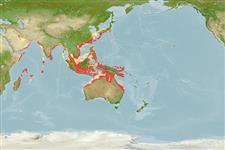Common names from other countries
Environment: milieu / climate zone / depth range / distribution range
Ökologie
seewasser; brackwasser demersal; tiefenbereich 0 - 60 m (Ref. 9804). Tropical; 20°C - 30°C (Ref. 13614); 37°N - 28°S, 48°E - 154°E
Indo-West Pacific: Red Sea (Ref. 130655), the Persian Gulf, Gulf of Oman, Arabian Sea, Bay of Bengal, and Japan (north to central Honshu), China, South China Sea including Gulf of Thailand, Indonesia, northern Australia.
Size / Gewicht / Alter
Maturity: Lm ? range ? - ? cm
Max length : 30.0 cm TL Männchen/unbestimmt; (Ref. 9804); common length : 25.0 cm TL Männchen/unbestimmt; (Ref. 3540)
Spiny dorsal-fin membrane very dark between first and third spines, and usually equally dark between third and fifth spines. Outline of head from base of first dorsal-fin spine to above eye an even slightly convex curve or almost a straight line (Ref 9804).
Inhabits sandy or muddy flat in coastal and estuarine waters. Feeds on benthic invertebrates. Sold fresh in markets. Used in Chinese medicine (Ref. 12166). Minimum depth range from Ref. 121772.
Life cycle and mating behavior
Maturities | Fortpflanzung | Spawnings | Egg(s) | Fecundities | Larven
Matsuura, K., 2001. Triacanthidae. Triplespines. p. 3905-3910. In K.E. Carpenter and V. Niem (eds.) FAO species identification guide for fishery purposes. The living marine resources of the Western Central Pacific. Vol. 6. Bony fishes part 4 (Labridae to Latimeriidae), estuarine crocodiles. FAO, Rome. (Ref. 9804)
IUCN Rote Liste Status (Ref. 130435)
CITES (Ref. 128078)
Not Evaluated
Bedrohung für Menschen
Harmless
Nutzung durch Menschen
Fischereien: weniger kommerziell
Tools
Zusatzinformationen
Download XML
Internet Quellen
Estimates based on models
Preferred temperature (Ref.
115969): 24.6 - 29.1, mean 28.2 (based on 1448 cells).
Phylogenetic diversity index (Ref.
82804): PD
50 = 0.7578 [Uniqueness, from 0.5 = low to 2.0 = high].
Bayesian length-weight: a=0.01072 (0.00523 - 0.02196), b=2.87 (2.68 - 3.06), in cm Total Length, based on LWR estimates for this species & (Sub)family-body (Ref.
93245).
Trophic level (Ref.
69278): 2.8 ±0.29 se; based on food items.
Widerstandsfähigkeit (Ref.
120179): mittel, Verdopplung der Population dauert 1,4 - 4,4 Jahre. (K=0.22).
Fishing Vulnerability (Ref.
59153): Moderate vulnerability (40 of 100).
